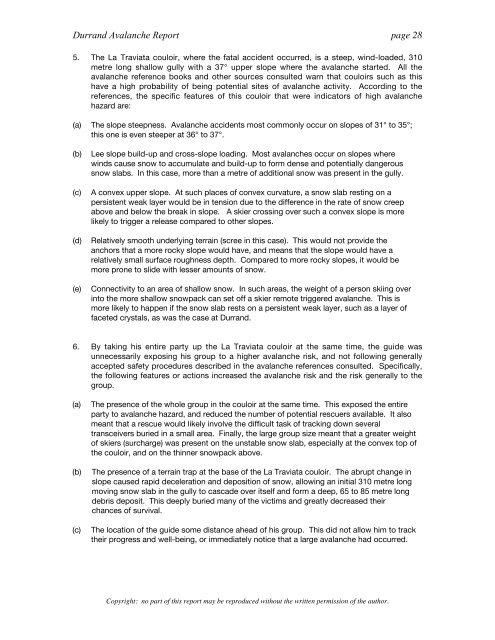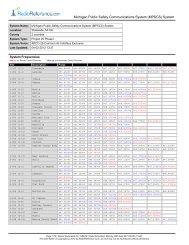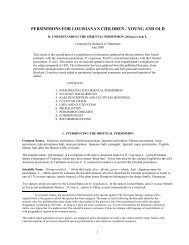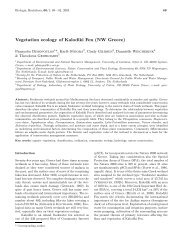Analysis of the Durrand Glacier Avalanche Accident
Analysis of the Durrand Glacier Avalanche Accident
Analysis of the Durrand Glacier Avalanche Accident
You also want an ePaper? Increase the reach of your titles
YUMPU automatically turns print PDFs into web optimized ePapers that Google loves.
<strong>Durrand</strong> <strong>Avalanche</strong> Report page 28<br />
5. The La Traviata couloir, where <strong>the</strong> fatal accident occurred, is a steep, wind-loaded, 310<br />
metre long shallow gully with a 37° upper slope where <strong>the</strong> avalanche started. All <strong>the</strong><br />
avalanche reference books and o<strong>the</strong>r sources consulted warn that couloirs such as this<br />
have a high probability <strong>of</strong> being potential sites <strong>of</strong> avalanche activity. According to <strong>the</strong><br />
references, <strong>the</strong> specific features <strong>of</strong> this couloir that were indicators <strong>of</strong> high avalanche<br />
hazard are:<br />
(a) The slope steepness. <strong>Avalanche</strong> accidents most commonly occur on slopes <strong>of</strong> 31° to 35°;<br />
this one is even steeper at 36° to 37°.<br />
(b) Lee slope build-up and cross-slope loading. Most avalanches occur on slopes where<br />
winds cause snow to accumulate and build-up to form dense and potentially dangerous<br />
snow slabs. In this case, more than a metre <strong>of</strong> additional snow was present in <strong>the</strong> gully.<br />
(c) A convex upper slope. At such places <strong>of</strong> convex curvature, a snow slab resting on a<br />
persistent weak layer would be in tension due to <strong>the</strong> difference in <strong>the</strong> rate <strong>of</strong> snow creep<br />
above and below <strong>the</strong> break in slope. A skier crossing over such a convex slope is more<br />
likely to trigger a release compared to o<strong>the</strong>r slopes.<br />
(d) Relatively smooth underlying terrain (scree in this case). This would not provide <strong>the</strong><br />
anchors that a more rocky slope would have, and means that <strong>the</strong> slope would have a<br />
relatively small surface roughness depth. Compared to more rocky slopes, it would be<br />
more prone to slide with lesser amounts <strong>of</strong> snow.<br />
(e) Connectivity to an area <strong>of</strong> shallow snow. In such areas, <strong>the</strong> weight <strong>of</strong> a person skiing over<br />
into <strong>the</strong> more shallow snowpack can set <strong>of</strong>f a skier remote triggered avalanche. This is<br />
more likely to happen if <strong>the</strong> snow slab rests on a persistent weak layer, such as a layer <strong>of</strong><br />
faceted crystals, as was <strong>the</strong> case at <strong>Durrand</strong>.<br />
6. By taking his entire party up <strong>the</strong> La Traviata couloir at <strong>the</strong> same time, <strong>the</strong> guide was<br />
unnecessarily exposing his group to a higher avalanche risk, and not following generally<br />
accepted safety procedures described in <strong>the</strong> avalanche references consulted. Specifically,<br />
<strong>the</strong> following features or actions increased <strong>the</strong> avalanche risk and <strong>the</strong> risk generally to <strong>the</strong><br />
group.<br />
(a) The presence <strong>of</strong> <strong>the</strong> whole group in <strong>the</strong> couloir at <strong>the</strong> same time. This exposed <strong>the</strong> entire<br />
party to avalanche hazard, and reduced <strong>the</strong> number <strong>of</strong> potential rescuers available. It also<br />
meant that a rescue would likely involve <strong>the</strong> difficult task <strong>of</strong> tracking down several<br />
transceivers buried in a small area. Finally, <strong>the</strong> large group size meant that a greater weight<br />
<strong>of</strong> skiers (surcharge) was present on <strong>the</strong> unstable snow slab, especially at <strong>the</strong> convex top <strong>of</strong><br />
<strong>the</strong> couloir, and on <strong>the</strong> thinner snowpack above.<br />
(b) The presence <strong>of</strong> a terrain trap at <strong>the</strong> base <strong>of</strong> <strong>the</strong> La Traviata couloir. The abrupt change in<br />
slope caused rapid deceleration and deposition <strong>of</strong> snow, allowing an initial 310 metre long<br />
moving snow slab in <strong>the</strong> gully to cascade over itself and form a deep, 65 to 85 metre long<br />
debris deposit. This deeply buried many <strong>of</strong> <strong>the</strong> victims and greatly decreased <strong>the</strong>ir<br />
chances <strong>of</strong> survival.<br />
(c) The location <strong>of</strong> <strong>the</strong> guide some distance ahead <strong>of</strong> his group. This did not allow him to track<br />
<strong>the</strong>ir progress and well-being, or immediately notice that a large avalanche had occurred.<br />
Copyright: no part <strong>of</strong> this report may be reproduced without <strong>the</strong> written permission <strong>of</strong> <strong>the</strong> author.

















